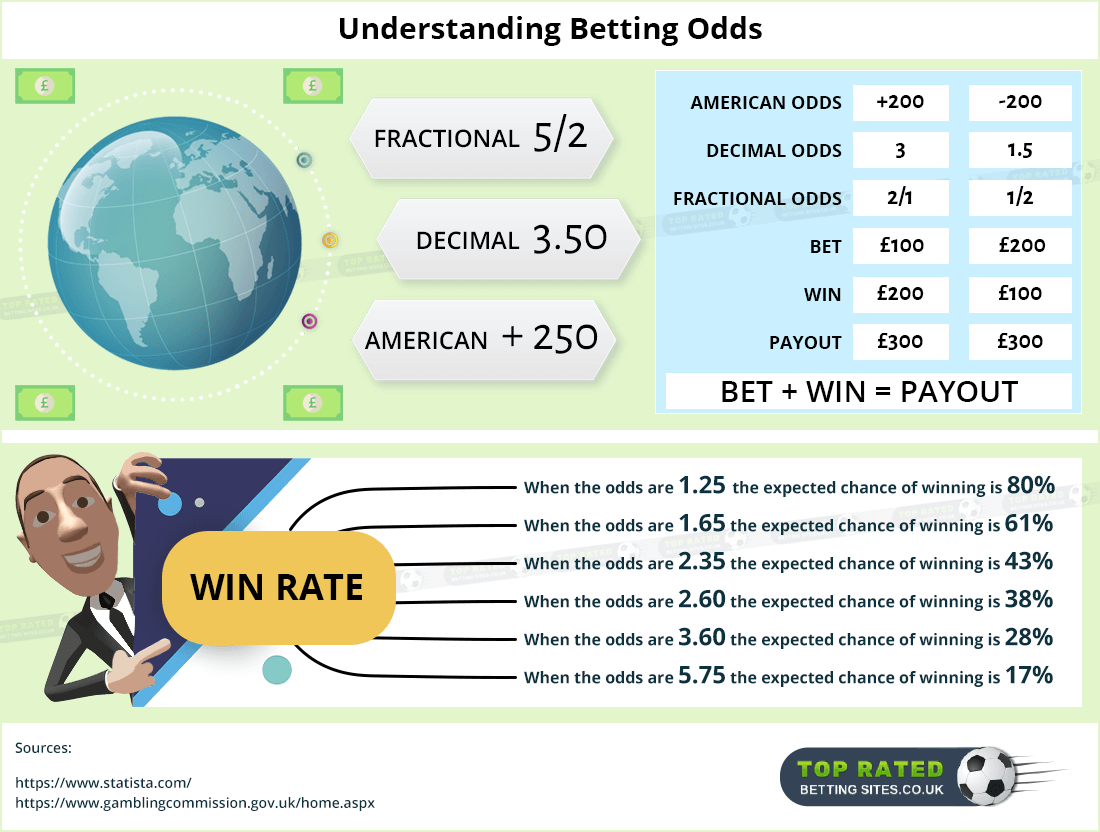Reading Betting Odds
Reading betting odds like these also tells us plenty about the game. There is no point spread with this wager so the moneyline is telling us who the straight-up favorite of the game is and just how much of a favorite they are in that game. It’s important when reading the betting odds to read all of the betting odds. Reading the Win Odds. The easiest information on the board is the win odds quoted on each horse.They don't tell you what the horse will pay, but the amount of profit you will get and the amount you have to bet to get it. How to Read American Odds American odds are centered around winning or wagering $100 on a given bet. If You’re Betting a Favorite: The odds for favorites will have a minus (-) sign in front, and indicate the money you need to risk to win $100. Betting odds represent the probability of a specific outcome. And, odds show the profit, or return, that you can get if your bet wins. This likelihood of a certain outcome is additionally known as the implied probability. You need to know what implied probability is if you are going to bet on sports. If you were to read betting odds of -150 out loud, you would say “minus one fifty”. The other side of American odds are underdogs. Underdogs have an implied probability of less than 50%. Underdog odds are always represented with a plus sign (+) in front of the number and will always be “positive odds.

Fractional odds are read as (how much you win)/(how much you bet)
Example:
Odds = 3/2
Stake = 100
Winnings = (100 x (3/2)) = 150
Fractional odds are the oldest way which bookmakers have displayed prices. They are harder to read than decimal odds, but are quite common and thusly worth learning. To decipher fractional odds, lets look at a tennis matchup between Novak Djokovic and Rafael Nadal:
Nadal – 4/6
Djokovic – 6/5
The easiest way to read fractional odds is to think of the price as:
The Amount You Win
The Amount You Bet
That means that if the number on top (the numerator) is bigger than the one on the bottom (denominator), then the market is an underdog, the side viewed as less likely to win the matchup. If the denominator is bigger than the numerator, you are looking at a favourite, the side viewed as more likely to win.
Of course, you are not always going to bet the denominator on a market, so how do you figure out the payout using fractional odds? To see how much you are set to win with fractional odds simply multiply the stake by the fraction. Using the example above, if we were to bet 100 on Djokovic we would see that we win 120, add back in your stake and you get a total payout of 220.
To convert any odds formats check out Pinnacle’s odds converter.

Upon first glance, the big board in any sportsbook can be somewhat intimidating. There are the moneylines and the point spreads and the totals, and it’s all smashed together in an effort to get as much information out there as possible. However, once you break all the numbers down, you’ll have a much clearer idea of just what all those numbers mean. Knowing how to read betting odds will not only make you a smarter gambler, it’ll make you a better one.
Moneylines
The moneylines are the numbers with the plus or minus sign in front of them. What that sign tells us is how much you’ll win wagering on that team. The plus sign denotes the amount of money you’ll win if you bet $100. The minus sign tells us the amount we would need to wager in order to win $100.
For example, in a game where the Steelers are -250, you would have to wager $250 to win $100. If the Browns are +150, you’d win $150 on a $100 wager. You don’t have to bet exactly $100, this is just the scale all American sportsbooks use. Reading betting odds like these also tells us plenty about the game.
There is no point spread with this wager so the moneyline is telling us who the straight-up favorite of the game is and just how much of a favorite they are in that game.
It’s important when reading the betting odds to read all of the betting odds. Many factors in the game reveal themselves in the betting odds numbers. The favorite, the underdog, if it will be a low scoring game, or a high scoring game. Remember, there’s more than what’s just on the surface when reading the betting odds.
Point Spreads
Playing the point spread is probably the most popular wager on the board. These spreads focus on the amount of points one team is favored by and must overcome in order to win the wager. Once again, you are looking for the plus or minus sign to denote the favorite or the underdog.

Plus is the underdog and minus is the favorite. If the Steelers are -8 point favorites, they would have to win the game by 9 points or more. If the Browns are +8 point underdogs, they could lose the game by 7 points or less and win the wager.
Point spreads are straight handicapping. The favorite gives points to level the playing field. This, in turn, levels out the payout odds as well. Most point spreads will payout between -105, -110, or -115 for both teams.
It rewards the gambler for reading the teams well enough to handicap the game. But remember, and this is important when reading betting odds, the point spreads are made not to create a level playing field between two teams, there made to get you to gamble. There’s a difference and it’s to be considered before placing any wager.
Totals
The totals wager is also known as the over/under. The number you see when reading betting odds is the combined score of both teams in a game. For this wager, it doesn’t matter who wins the game. You are wagering on the scoring of the game, not the winner or loser. At the end of the game, the totaled final score will be either over the totals number or below it.
For instance, in our Steelers/Browns game, the over/under is set at 40 points. If you have the under, you want the combined score of both the Steelers and the Browns to be 39 points or less. If you have the over, you want the combined score to be 41 points or more. Again, this is a handicapping-type wager so it usually pays out the same the point spreads, -105, -110, or -115.
Push
A push is simply a tie and can occur only two of these wagers: the point spread and the totals. If the team ends in a tie after the point spread is applied, it’s a push. If the combined score of the game is the exact same as the over/under, it’s a push. No one wins a push and all money wagered is returned. Side note, on the moneyline, if the game ends in a tie, no one wins. The moneyline bet pays winners only, not tie-ers.
All Together Now
Now that we know what all of the numbers indicate, we can make a smarter wager on our Steelers/Browns game. The Steelers are -250 and giving 8 points while the Browns are +150 and getting 8 points where the over/under is 40.

What does this information tell us? Obviously, the first thing is that the Steelers are the favorites and the Browns the underdogs. Secondly, the over/under is 40 which means this isn’t expected to be a high scoring NFL game. Then the 8 point spread. Is it possible for the Steelers to win the game by the 8 points and still have a total of less than 39? Probably not.
Therefore, if you like the Steelers, the smart wager is the Steelers on the moneyline, the point spread, and the over. All the information is there. Learn how to read betting odds, learn to make better bets.
How To Read Betting Lines
- Tags: